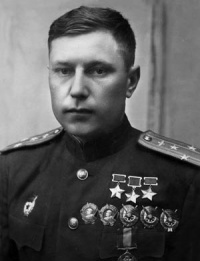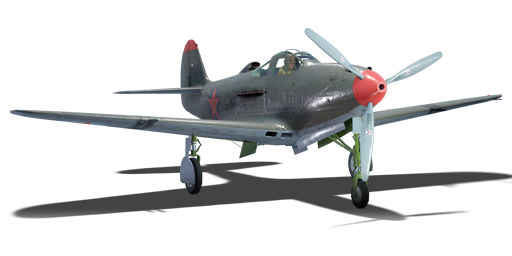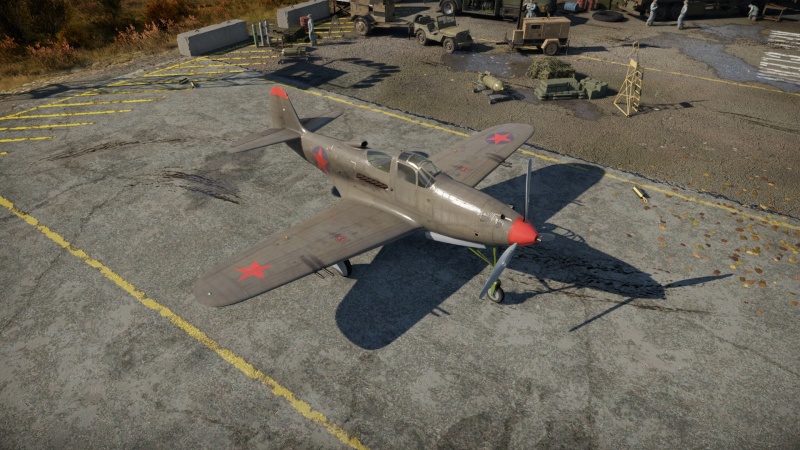P-39K-1 (USSR)
| This page is about the premium Russian fighter P-39K-1 (USSR). For other uses, see P-39 (Family). |
Contents
Description
The ▂P-39K-1 Airacobra is a premium rank II Soviet fighter with a battle rating of 3.3 (AB), 2.7 (RB), and 3.0 (SB). It has been in the game since the start of the Open Beta Test prior to Update 1.27. It costs 1,000 Golden Eagles.
General info
Flight performance
Describe how the aircraft behaves in the air. Speed, manoeuvrability, acceleration and allowable loads - these are the most important characteristics of the vehicle.
| Characteristics | Max Speed (km/h at 3,900 m) |
Max altitude (metres) |
Turn time (seconds) |
Rate of climb (metres/second) |
Take-off run (metres) | |||
|---|---|---|---|---|---|---|---|---|
| AB | RB | AB | RB | AB | RB | |||
| Stock | 563 | 546 | 9500 | 21.2 | 22.0 | 8.7 | 8.7 | 300 |
| Upgraded | 622 | 590 | 19.5 | 20.0 | 18.8 | 12.9 | ||
Details
| Features | ||||
|---|---|---|---|---|
| Combat flaps | Take-off flaps | Landing flaps | Air brakes | Arrestor gear |
| ✓ | ✓ | ✓ | X | X |
| Limits | ||||||
|---|---|---|---|---|---|---|
| Wings (km/h) | Gear (km/h) | Flaps (km/h) | Max Static G | |||
| Combat | Take-off | Landing | + | - | ||
| 0 | 322 | 420 | 340 | 233 | ~12 | ~9 |
| Optimal velocities (km/h) | |||
|---|---|---|---|
| Ailerons | Rudder | Elevators | Radiator |
| < 360 | < 380 | < 450 | > 312 |
| Compressor (RB/SB) | ||
|---|---|---|
| Setting 1 | ||
| Optimal altitude | 100% Engine power | WEP Engine power |
| 4,000 m | 1,150 hp | 1,479 hp |
Survivability and armour
- 6 mm steel behind oil cooling system
- 6 mm steel behind pilot
- 15.87 mm steel in front of pilot
- 15.87 mm ring immediately behind propeller hub
- 38 mm bulletproof glass in front of pilot
- 64 mm bulletproof glass behind pilot
- Self sealing fuel tanks (one in each wing)
Modifications and economy
Armaments
Offensive armament
The P-39K-1 (USSR) is armed with:
- 1 x 37 mm M4 cannon, nose-mounted (30 rpg)
- 2 x 12.7 mm M2 Browning machine guns, nose-mounted (200 rpg = 400 total)
- 4 x 7.62 mm Browning machine guns, wing-mounted (300 rpg = 1,200 total)
Usage in battles
Describe the tactics of playing in the aircraft, the features of using aircraft in a team and advice on tactics. Refrain from creating a "guide" - do not impose a single point of view, but instead, give the reader food for thought. Examine the most dangerous enemies and give recommendations on fighting them. If necessary, note the specifics of the game in different modes (AB, RB, SB).
Manual Engine Control
| MEC elements | ||||||
|---|---|---|---|---|---|---|
| Mixer | Pitch | Radiator | Supercharger | Turbocharger | ||
| Oil | Water | Type | ||||
| Controllable | Controllable Not auto controlled |
Controllable Auto control available |
Controllable Auto control available |
Separate | Not controllable 1 gear |
Not controllable |
Pros and cons
Pros:
- Good fire power
- Well armoured
- Cockpit has good visibility
- Powerful engine
Cons:
- 37 mm M4 cannon isn't very accurate
- No suspended ordnance options
- The engine is centrally mounted, taking engine damage while being chased is common
History
Describe the history of the creation and combat usage of the aircraft in more detail than in the introduction. If the historical reference turns out to be too long, take it to a separate article, taking a link to the article about the vehicle and adding a block "/History" (example: https://wiki.warthunder.com/(Vehicle-name)/History) and add a link to it here using the main template. Be sure to reference text and sources by using <ref></ref>, as well as adding them at the end of the article with <references />. This section may also include the vehicle's dev blog entry (if applicable) and the in-game encyclopedia description (under === In-game description ===, also if applicable).
In-game description
In developing this aircraft, the Bell designers came up against two global problems. The first was that the P-39 was intended for export, and there was no way around this. The impossibility of fitting a turbo compressor to the low-altitude Allison engine (for fully explicable reasons) was one reason why the aircraft was never able to achieve a worthy place in the US air forces. The nature of air combat, both in Europe and the Far East, prevented the P-39 from making use of its advantages, while it was not possible to rectify its main drawback - its poor high-speed performance - because of the ban on exporting turbo compressors outside the USA.
The second global problem was connected to a technical failure in the production of the 20 mm Hispano-Suiza AN-M1/M2C cannon by the Bendix company. This was the first problem the Bell specialists tried to tackle. The Bell specialists initially tried to solve this problem themselves. The virtually unusable 20 mm cannon was replaced by the old, heavy but more reliable Colt-Browning M4. The cannon had a lot of faults, mainly its low rate of fire and extremely inadequate stock of ammunition - only 30 shells. On the other hand, in spite of its weight, it could easily be fitted in the front part of the Cobra's fuselage; furthermore, it has one incomparable advantage over the Bendix product - it actually fired.
It must be noted that the M1 cannon was not always fitted onto the first series of the P-39, you could find the M4 here and there. Only the Model 26 (P-39G) carried the M4 as standard equipment. However, it did not go into production, but became the founder of a whole number of virtually identical series from P-39K to P-39Q. The main units were borrowed from the quite promising P-39D-2 series.
The P39K differed from the earlier models in its engine, the Allison V-1710-63, which was successfully tested in that same D-2. It was fitted with an afterburner system. It developed a nominal power of 1352 h.p. and 1550 h.p. in WEP (War Emergency Power) mode. The K series was the only one fitted with such an engine along with a three-bladed Aeroprop propeller. It was a full 360 kg heavier than the D-2, although externally, apart from the propeller, there was no visible difference. In fact, the extra weight was due to additional armor plating, which was used beginning with the K and on all subsequent series.
Altogether, by August 1941, 210 examples of the series K-1-BE, K-2-BE and K-5-BE, which were virtually identical, were built. Forty of them were sent to the USSR.
Notable pilots
-
 Alexander Pokryshkin flew the ▂P-39K-1 Airacobra during the battle of Kuban starting his 47 kill-streak with the P-39 series lend-lease aircraft.
Alexander Pokryshkin flew the ▂P-39K-1 Airacobra during the battle of Kuban starting his 47 kill-streak with the P-39 series lend-lease aircraft.
Media
See also
Links to the articles on the War Thunder Wiki that you think will be useful for the reader, for example:
- reference to the series of the aircraft;
- links to approximate analogues of other nations and research trees.
External links
| Bell Aircraft Corporation | |
|---|---|
| Aircraft | |
| Fighters | P-39N-0 · P-39Q-5 |
| P-400 | |
| P-63A-10 · P-63A-5 · P-63C-5 · ␠Kingcobra | |
| Jet Fighters | P-59A |
| Export | ▂P-39K-1 · ▂Pokryshkin's P-39N-0 · ▂P-39Q-15 · ▄P-39Q-25 |
| ▂P-63A-5 · ▂P-63A-10 · ▂P-63C-5 · ▄P-63C-5 | |
| Helicopters | |
| Attack | AH-1F · AH-1G · AH-1Z · AH-1W |
| OH-58D | |
| Utility | UH-1B · UH-1C · UH-1C XM-30 |
| Export/Licensed | ▅UH-1B · ◄UH-1D |
| Tzefa A · Tzefa B · Tzefa D/E · ▅AH-1S early · ▅AH-1S · ▅AH-1S Kisarazu · ␗AH-1W | |
| ␗OH-58D | |
| See Also | Fuji Heavy Industries · Agusta |
| USSR fighters | |
|---|---|
| I-15 | I-15 WR · I-15 M-22 · I-15 M-25 · I-15bis · Krasnolutsky's I-15bis |
| I-153 M-62 · Zhukovsky's I-153-M62 · I-153P | |
| I-16 | I-16 type 5 · I-16 type 10 · I-16 type 18 · I-16 type 24 · I-16 type 27 · I-16 type 28 · I-180S |
| I-29 | I-29 |
| I-185 | I-185 (M-71) · I-185 (M-82) |
| I-225 | I-225 |
| ITP | ITP (M-1) |
| MiG-3 | MiG-3-15 · MiG-3-15 (BK) · MiG-3-34 |
| LaGG | I-301 · LaGG-3-4 · LaGG-3-8 · LaGG-3-11 · LaGG-3-23 · LaGG-3-34 · LaGG-3-35 · LaGG-3-66 |
| La | La-5 · La-5F · La-5FN · La-7 · Dolgushin's La-7 · La-7B-20 · La-9 · La-11 |
| Yak-1/7 | Yak-1 · Yak-1B · Yak-7B |
| Yak-3 | Yak-3 · Eremin's Yak-3(e) · Yak-3P · Yak-3T · Yak-3U · Yak-3 (VK-107) |
| Yak-9 | Yak-9 · Yak-9B · Golovachev's Yak-9M · Yak-9T · Yak-9K · Yak-9U · Yak-9UT · Yak-9P |
| Other countries | ▂P-40E-1 · ▂P-47D-27 · ▂Hurricane Mk IIB · ▂Fw 190 D-9 · ▂Spitfire Mk IXc |
| P-39 | ▂P-39K-1 · ▂Pokryshkin's P-39N-0 · ▂P-39Q-15 |
| P-63 | ▂P-63A-5 · ▂P-63A-10 · ▂P-63C-5 |
| USSR premium aircraft | |
|---|---|
| Fighters | Krasnolutsky's I-15bis · I-16 type 28 · Zhukovsky's I-153-M62 · I-153P · I-180S · I-301 · ITP (M-1) |
| LaGG-3-4 · LaGG-3-23 · LaGG-3-34 · Dolgushin's La-7 · La-11 | |
| Eremin's Yak-3(e) · Yak-3 (VK-107) · Yak-3T · Golovachev's Yak-9M | |
| ▂P-39K-1 · ▂Pokryshkin's P-39N-0 · ▂P-39Q-15 · ▂P-40E-1 · ▂P-47D-27 · ▂P-63A-5 · ▂P-63A-10 · ▂P-63C-5 | |
| ▂Hurricane Mk IIB · ▂Spitfire Mk IXc · ▂Fw 190 D-9 | |
| Twin-engine fighters | I-29 |
| Jet fighters | Su-11 · MiG-15bis ISh · MiG-17AS · MiG-21S (R-13-300) · MiG-23ML |
| Strike aircraft | IL-2M "Avenger" · IL-2 M-82 · IL-8 (1944) · Su-6 · Tandem MAI · TIS MA · Su-8 · Tu-1 |
| Yak-38 · Su-7BMK · Su-25K · Su-39 | |
| Bombers | Po-2M · Be-6 · MBR-2-M-34 · Pe-2-205 · TB-3M-17-32 |
| ▂PBY-5A Catalina · ▂Hampden TB Mk I · ▂A-20G-30 · ▂B-25J-30 | |





